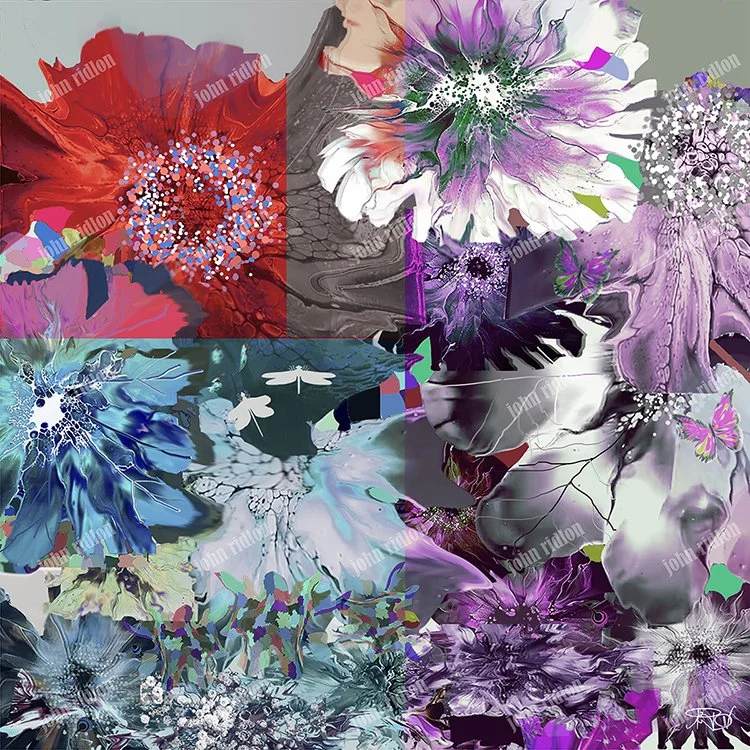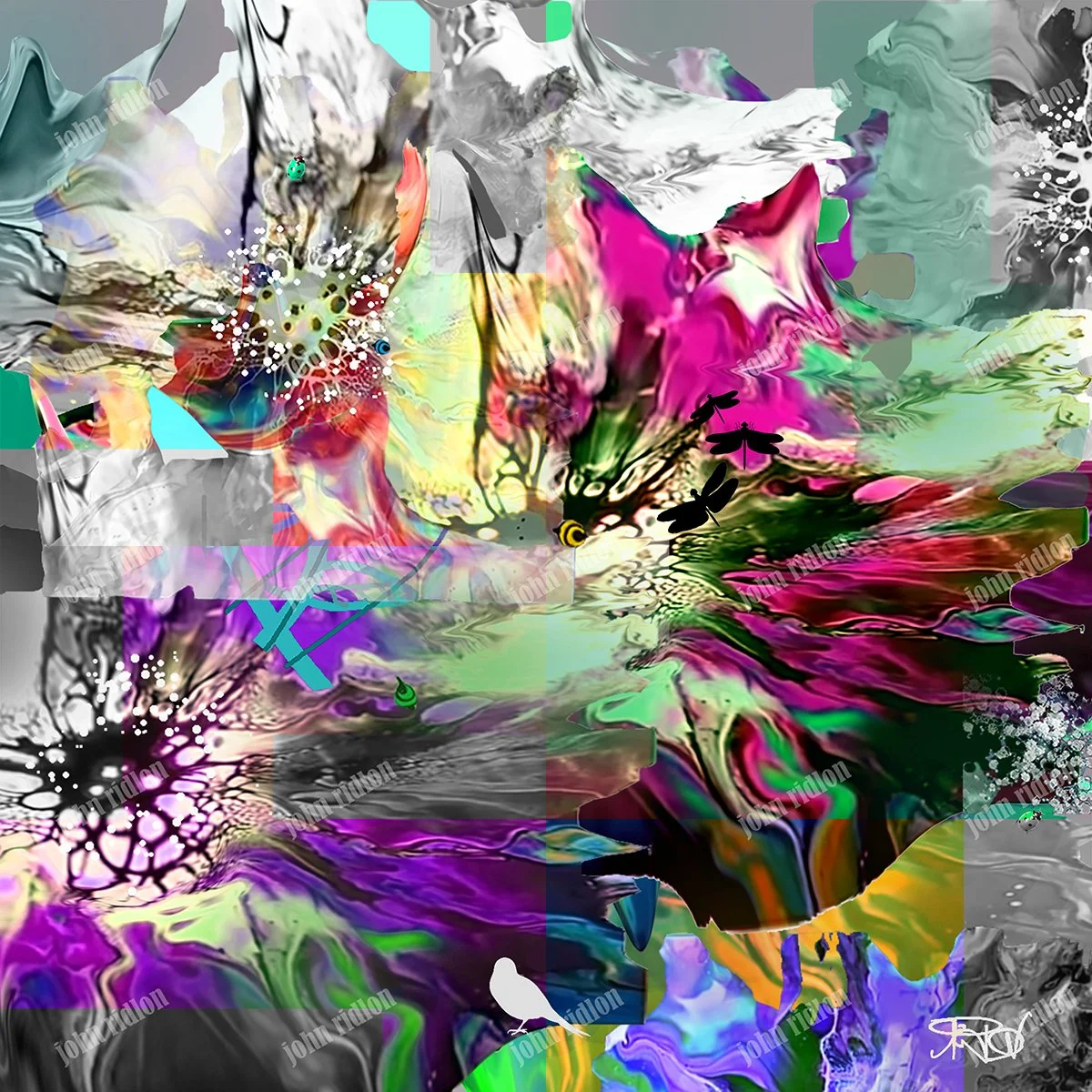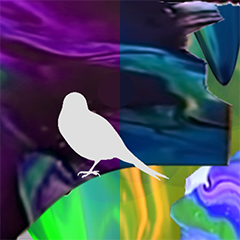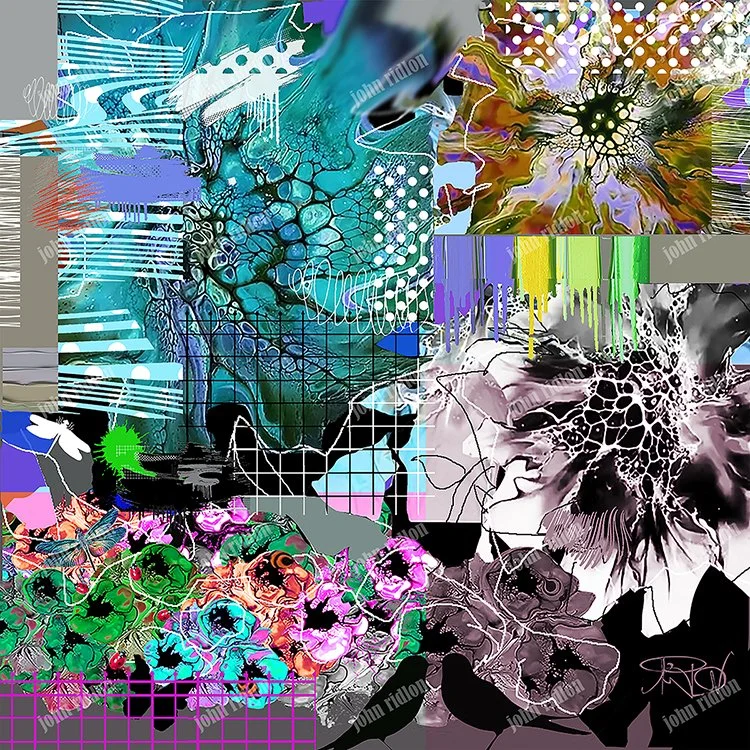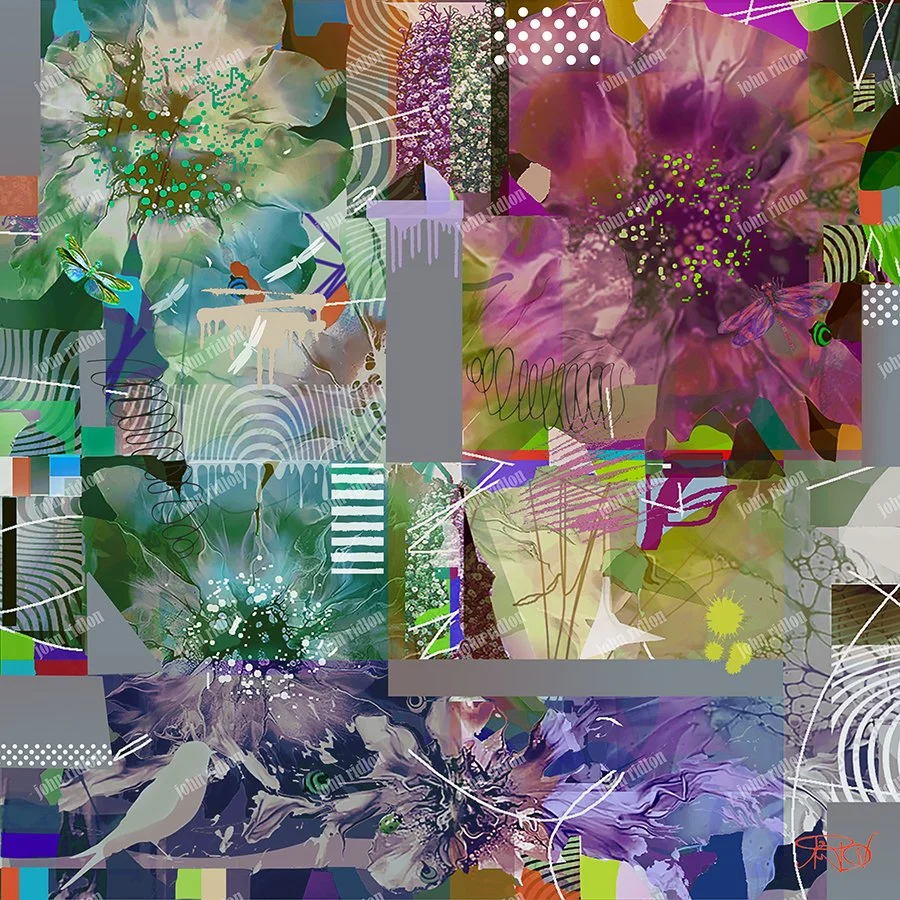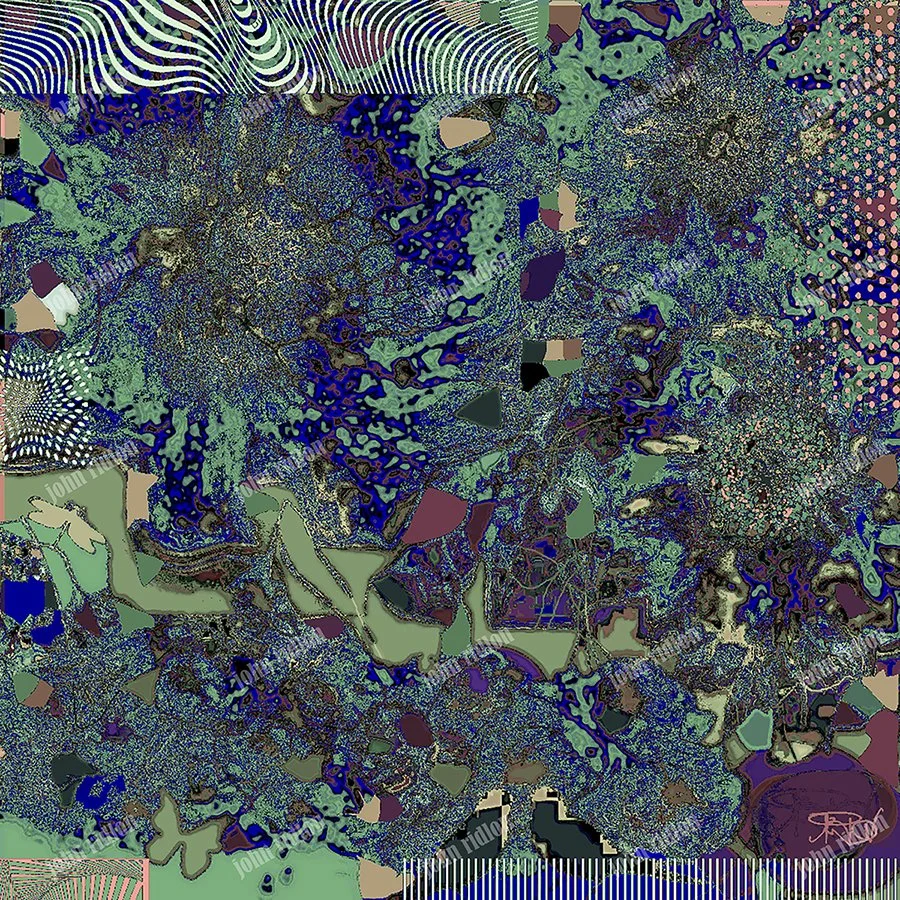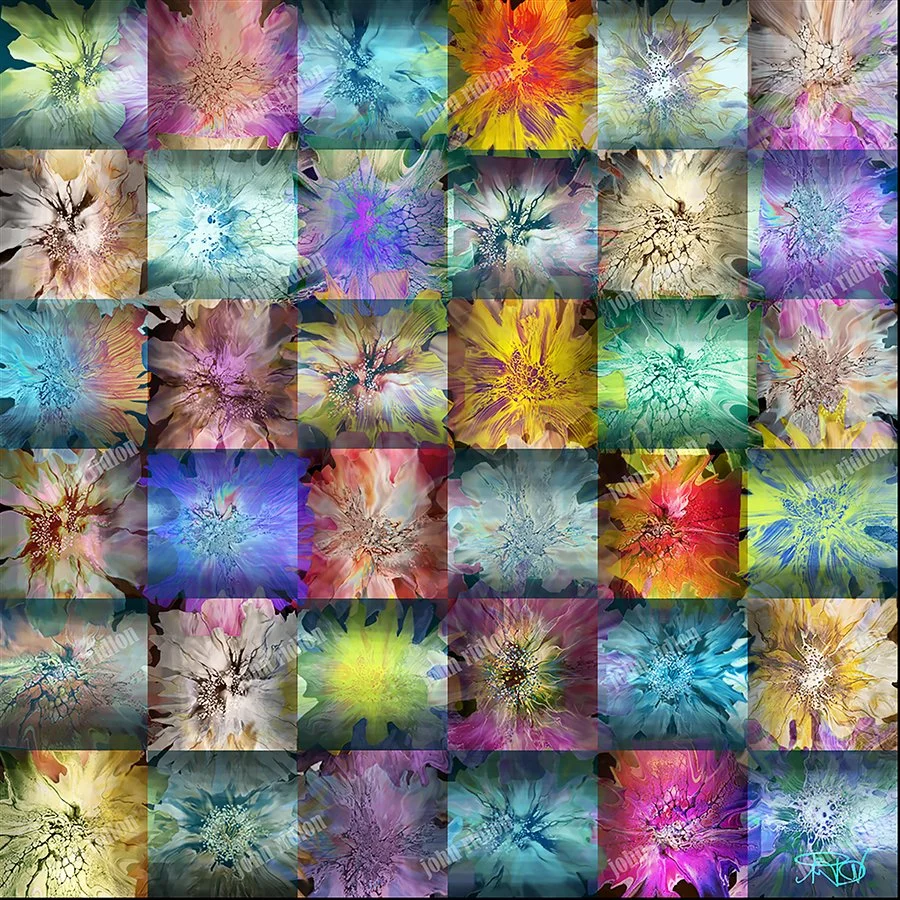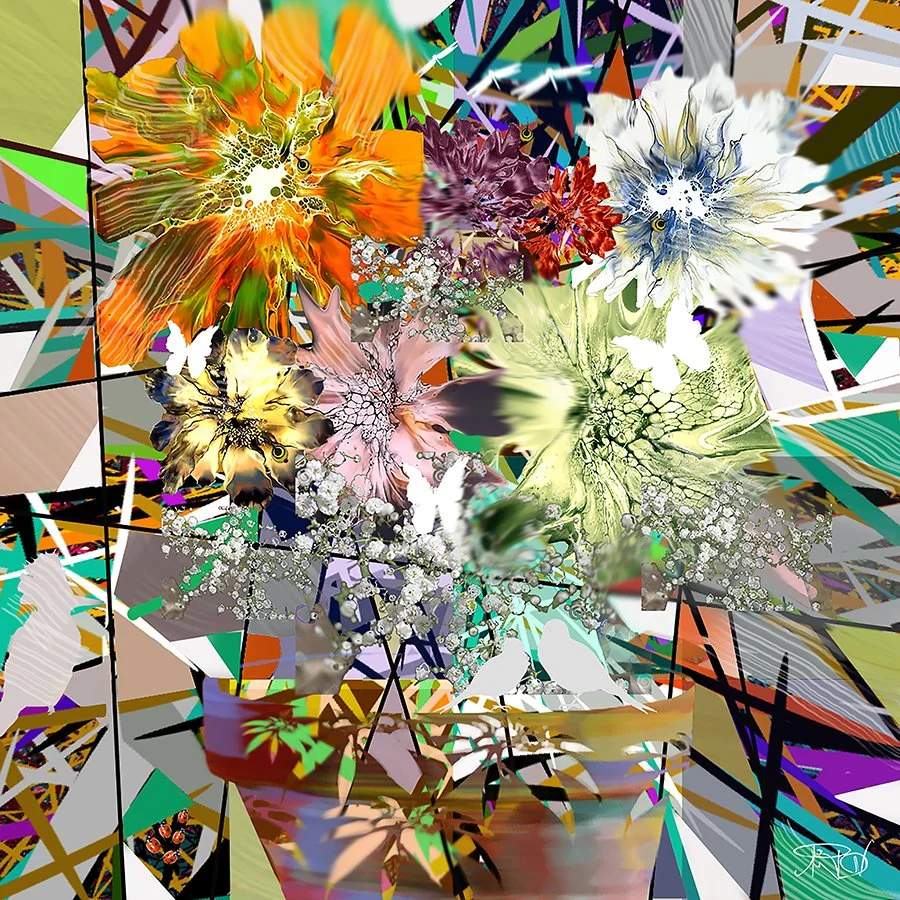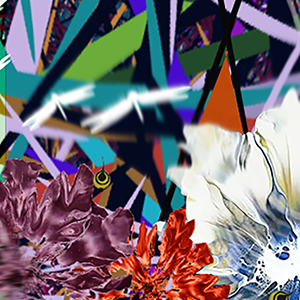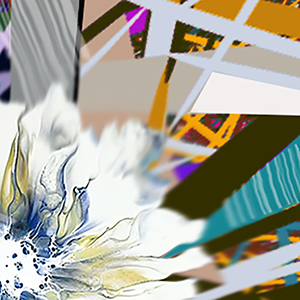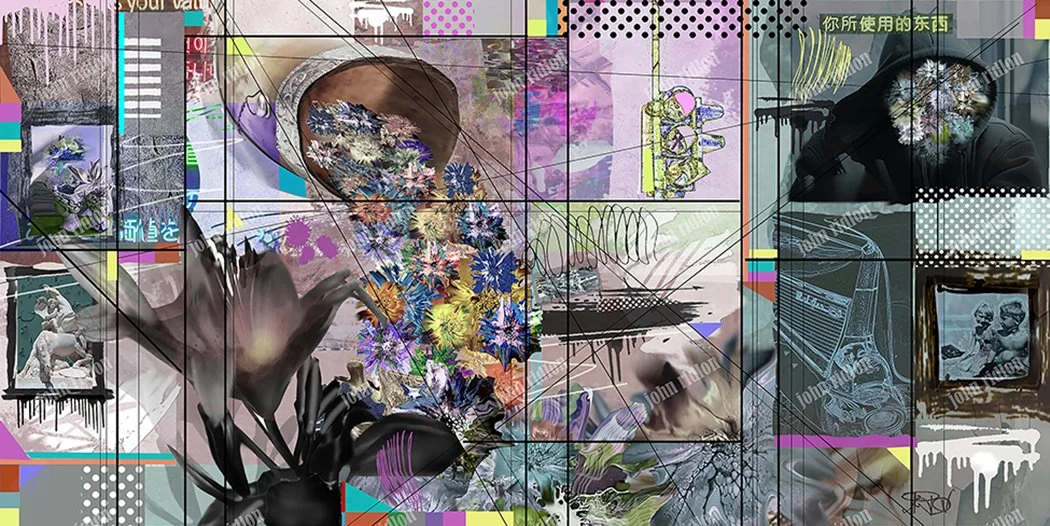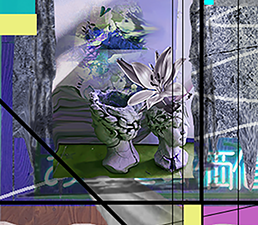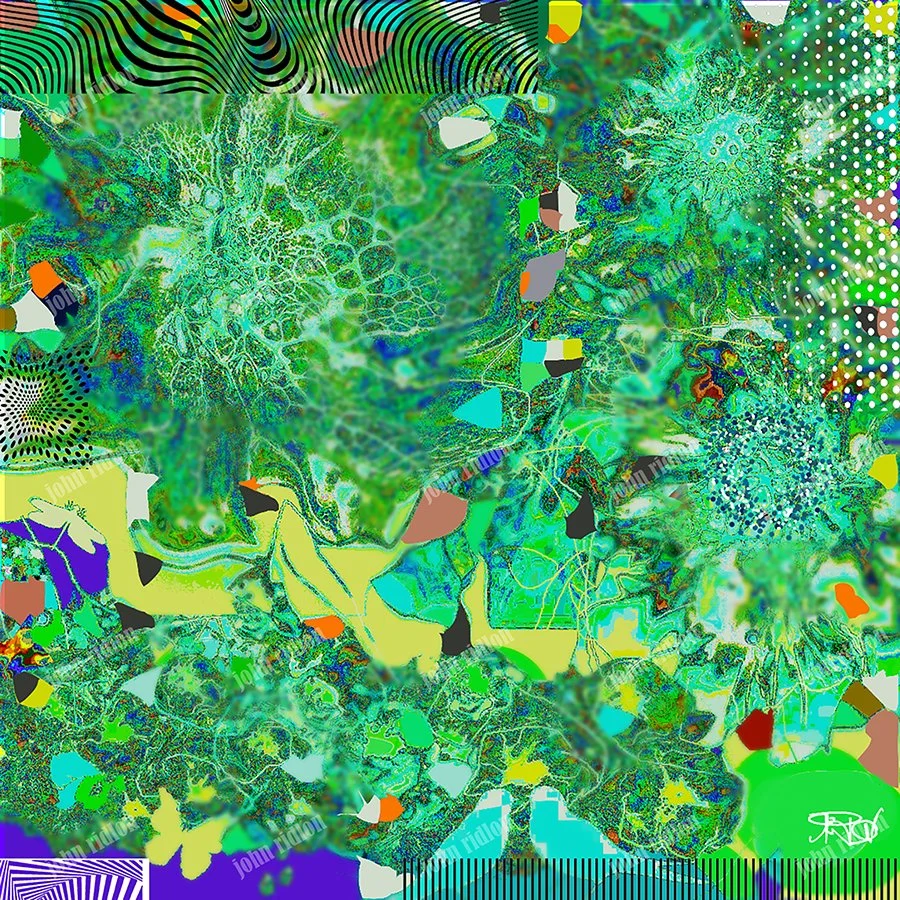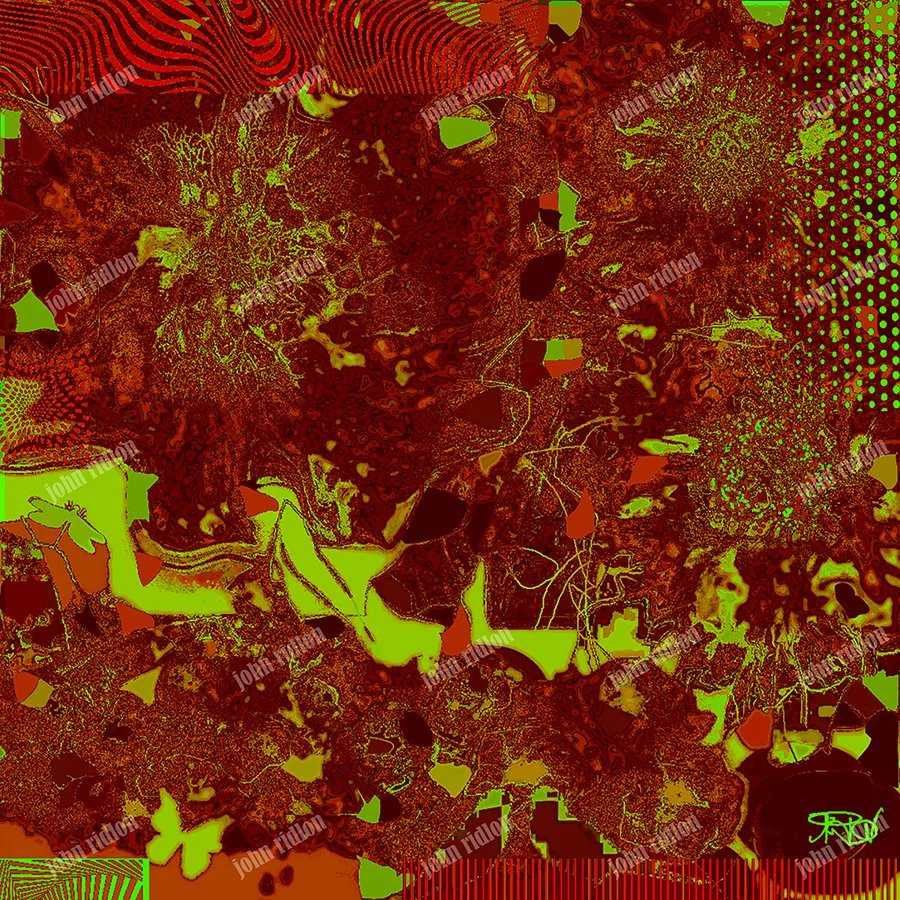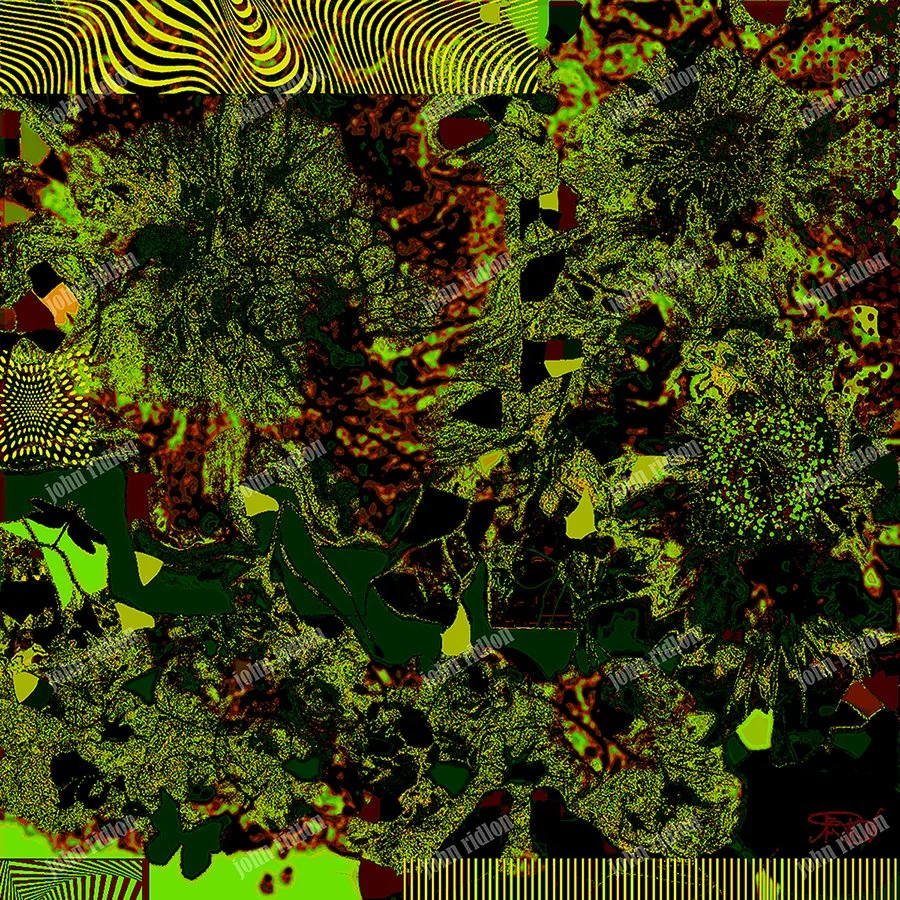John Ridlon
Ambrosian Promise
Perhaps you’d like to buy a flower?
But I could never sell.
If you would like to borrow
Until the daffodil
Unties her yellow bonnet
Beneath the village door,
Until the bees, from clover rows
Their hock and sherry draw,
Why, I will lend until just then,
But not an hour more!
~ Emily Dickinson
Ambrosian Promise ll
Ambrosian Promise lll
Beau Geste
Diaphania
Diaphania ll
Elysian Mirage
Floral Wall
Floral Weave
Spring Bouquet
Wild Flowers
Pink Maze
Black Widow
Elysian Mirage ll
Elysian Mirage lll
Elysian Mirage lV
History of Floral Design
The commercial floral design industry has been shaped by Eastern, Western, and European influences. Western design is known for its use of symmetrical and asymmetrical arrangements, as well as horizontal and vertical styles. The tradition of flower arranging dates back to Ancient Egypt and has evolved across cultures and centuries.
Ancient Civilizations
The Egyptians were among the earliest to place lotus flowers and buds in vases, nearly 4,000 years ago. They also crafted bouquets, wreaths, garlands, headwear, and decorative collars—often using lotus and papyrus, which were considered sacred to the goddess Isis. Ancient Greeks and Romans contributed by creating garlands and wreaths for adornment, and cornucopias filled with fruits and vegetables as offerings in religious ceremonies.
Asia
Chinese and Korean floral designs are deeply rooted in philosophical traditions. They reflect Confucian ideals of contemplation, Buddhist principles of preservation, and Taoist symbolism. These arrangements often feature containers of varying shapes and heights, incorporating natural elements like rocks to evoke harmony and balance.
Japan’s contribution is the art of Ikebana, a minimalist and meditative style that emphasizes three primary lines representing heaven, humanity, and earth. Ikebana focuses on line, space, and form, often using fewer materials to create profound visual impact.
Europe
During the Renaissance, floral arrangements became rich in symbolism and color. Designers used vivid, contrasting triadic palettes and combined fresh and dried materials—including fruits and vegetables. These compositions were often triangular, arching, or elliptical in shape.
French floral design embraced soft pastel tones and a light, airy aesthetic. Rather than emphasizing the whole arrangement, it celebrated the individual beauty of each flower. These pieces were semi-ovoid, feminine, symmetrical, and rhythmically styled with curves and flourishes.
English floral design drew inspiration from the abundance of plant life found in estates and countryside gardens. Arrangements were typically formal, triangular, and symmetrical, reflecting the structured elegance of the period.
The Americas
In Colonial America (1607–1699), floral arrangements were made from wildflowers, grasses, and seed pods gathered from the surrounding landscape. These designs reflected a modest lifestyle with limited luxuries, mirroring the simplicity of early settlers. Over time, American floral design absorbed European influences, evolving into more refined compositions that echoed the symmetry and sophistication of European styles.
Modern Floral Design
A New Era of Expression
By the mid-20th century, floral design began to be recognized not just as decoration, but as a legitimate art form. While many contemporary designers still draw inspiration from the naturalistic styles of the 19th century, there has been a strong push to break away from the rigid rules and formal patterns of traditional arrangements.
This shift led to the rise of abstract floral design, where conventional structure is intentionally disregarded in favor of bold, expressive compositions. Yet not all designers embraced abstraction. Many sought to innovate while maintaining harmony and structure, giving birth to new design styles that blend tradition with modern creativity.
Today’s floral arrangements reflect this duality. They range from:
• Zero abstraction – where flowers and components are left untreated and arranged in a natural, organic way
• Total abstraction – where form, proportion, and traditional rules are completely reimagined or ignored
This spectrum allows designers to explore personal expression, cultural influences, and artistic freedom in limitless ways.
Contemporary Floral Styles
Modern floral design encompasses a wide variety of styles, each with its own aesthetic, technique, and purpose. Some of the most popular include:
• Botanical Style – Emphasizes scientific accuracy and natural presentation
• Garden Style – Includes hand-tied bouquets, compote arrangements, and armature-based designs
• Crescent Corsage – Features a curved, elegant shape often used in wearable floral art
• Nosegay Corsage – A compact, round bouquet traditionally worn or carried
• Pot au Fleur – A lush, garden-like arrangement in a pot or container
• Inverted "T" – A structured design with vertical and horizontal emphasis
• Parallel Systems – Uses grouped vertical lines and spacing for a modern, architectural look
• Western Line – A classic American style emphasizing strong lines and symmetry
• Hedgerow Design – Mimics the look of a trimmed hedge with horizontal layering
• Mille de Fleur – A “thousand flowers” approach, densely packed with blooms
• Formal Linear – A minimalist style using few elements with strong directional lines
These styles offer designers a rich palette for creativity, whether the goal is elegance, drama, simplicity, or whimsy.
Principles of Floral Design
To create visually compelling and harmonious arrangements, designers often rely on seven core principles:
1. Proportion
• Refers to the size relationship between flowers, foliage, containers, and accessories
• Ensures that no element overwhelms or underwhelms the overall composition
2. Scale
• Focuses on how the arrangement fits within its environment or display space
• A large centerpiece should suit a grand room, while a petite bouquet fits a small table
3. Balance
• Includes both physical balance (stability and weight distribution) and visual balance (how the arrangement feels to the eye)
• Visual balance can be symmetrical, asymmetrical, or open
4. Focal Point
• The area that immediately draws the viewer’s attention
• Often created using color contrast, unique shapes, or dominant blooms
5. Rhythm
• Guides the viewer’s eye through the arrangement
• Achieved through repetition, variation, and movement in lines, shapes, and textures
6. Harmony
• The pleasing combination of elements—color, texture, material—that feel cohesive
• Ensures that all components work together rather than compete
7. Unity
• The sense that everything belongs and contributes to the whole
• Achieved when all other principles are successfully integrated
It’s important to note that not all arrangements follow these principles strictly. For example:
• French Baroque and Rococo styles often omit a focal point
• Rococo designs may disregard proportion, favoring tall, dramatic shapes
• Some traditional styles ignore spacing, affecting rhythm
• Modern abstract designers may intentionally break all seven principles to challenge convention
Elements of Floral Design
In addition to the guiding principles, floral designers also work with five essential elements that shape the visual and tactile experience of an arrangement:
1. Line
• Defines the structure and direction of the design
• Can be defined (clearly visible) or implied (suggested through color or texture transitions)
• Helps create movement and flow
2. Color
• Sets the mood and emotional tone of the arrangement
• Designers use schemes like monochromatic, triadic, analogous, or complementary to evoke different feelings
3. Form
• Refers to the height, width, and depth of the arrangement
• Works closely with line to establish the overall shape and silhouette
4. Space
• Involves the placement and spacing of flowers and foliage
• Prevents overcrowding and ensures each element is visible and appreciated
5. Texture
• Adds visual interest and tactile contrast
• Can be smooth, rough, glossy, wrinkled, or velvety
• Texture plays a key role in creating rhythm and depth
Together, these elements allow designers to craft arrangements that are not only beautiful but also emotionally resonant and artistically refined.
Categories of Flowers in Floral Design
Floral designers typically classify flowers into four main categories based on their function within an arrangement: line flowers, form flowers, mass flowers, and filler flowers. Each plays a distinct role in achieving balance, rhythm, and visual interest.
Line Flowers
Line flowers are tall, vertical blooms that define the shape and structure of an arrangement. They establish the height, width, and directional flow, guiding the viewer’s eye through the design. These flowers often bloom along the stem, with larger blossoms at the base tapering to smaller ones near the tip—creating a natural rhythm.
• Characteristics: Tall, spiked, directional
• Design Role: Outline and movement
• Examples: Snapdragons, delphiniums, liatris, gladiolus, stock, cattails, pussywillows, Bells of Ireland
Form Flowers
Form flowers are visually striking due to their unique shape, color, or texture. They serve as focal points, drawing attention and adding drama to the arrangement. These flowers often have exotic or sculptural qualities that make them stand out.
• Characteristics: Distinctive, bold, eye-catching
• Design Role: Focal point and emphasis
• Examples: Orchids, calla lilies, anthurium, irises, moth orchids
Mass Flowers
Mass flowers feature a single stem topped with a rounded, full bloom. They add volume and visual weight to the arrangement and are often placed near the container’s rim or clustered to create density. Designers may use multiple types of mass flowers to avoid monotony and add variety.
• Characteristics: Rounded, full-bodied, solid
• Design Role: Volume and visual weight
• Examples: Carnations, chrysanthemums, daisies, anemones, dahlias, hydrangeas, roses
Filler Flowers
Filler flowers consist of small sprays or clusters that fill gaps and soften the overall composition. They add texture, depth, and cohesion, helping to unify the design and support the primary flowers.
• Characteristics: Small, delicate, airy
• Design Role: Fill space and add dimension
• Examples: Baby’s breath, statice, waxflower
Flexible Categorization
It’s important to note that flower categories are not rigid. A single flower may serve different roles depending on its size, variety, and placement. For instance:
• Chrysanthemums can be mass or filler flowers
• Orchids and anthuriums may be used as form or mass flowers
Additional Popular Flowers
Floral designers often incorporate a wide range of blooms beyond the core categories. These include:
• Peruvian lilies
• Cosmos
• Freesias
• Gardenias
• Hyacinths
• Kalanchoe
• Larkspur
• Lavender
• Lilac
• Lilies
• Limonium
• Lupine
• Peonies
• Phlox
• Protea
• Ranunculus
• Sedum
• Solidago
• Sunflowers
• Tulips
• Zinnias
Categories of Foliage in Floral Design
Just like flowers, foliage is categorized into four types—line, form, mass, and filler—each complementing the floral components and enhancing the overall design.
Line Foliage
Line foliage mirrors the function of line flowers by reinforcing directional flow and structure. These leaves are often long and narrow, either straight or gently curved, and help create repetition and unity.
• Design Role: Structure and movement
• Examples: Bear grass, flax, ivy, sword fern
Form Foliage
Form foliage features distinctive shapes, textures, or colors that make it stand out. It’s often used to highlight focal points and create visual interest, contributing to the element of space in the arrangement.
• Design Role: Emphasis and contrast
• Examples: Seeded eucalyptus, calathea, equisetum, dieffenbachia, galax
Mass Foliage
Mass foliage adds bulk and visual weight, similar to mass flowers. It’s also useful for concealing mechanics like floral foam or tape, and for filling areas not occupied by blooms.
• Design Role: Volume and coverage
• Examples: Leatherleaf fern, salal
Filler Foliage
Filler foliage is used to create harmony and soften the arrangement. Depending on its texture, it can either lighten the design or add contrast. Fine, airy foliage creates softness, while coarse foliage adds boldness.
• Design Role: Texture and unity
• Examples: Plumosa asparagus, sprengeri fern, huckleberry, boxwood
Flexible Use of Foliage
As with flowers, foliage types can serve multiple roles. For example:
• Leatherleaf fern may be used as mass or line foliage
• Ruscus can function as form or line foliage
Additional Common Foliage
Designers often incorporate a variety of foliage to enhance texture, color, and form. Popular choices include:
• Italian ruscus
• Israeli ruscus
• Dusty miller
• Monstera deliciosa
• Eucalyptus (silver dollar, gunnii, baby blue)
• Tree fern
• Camellia
• Olive branches
• Hypericum berries
• Pittosporum
Preserved Materials in Floral Design
Preserved and dried materials are a vital extension of floral design, offering longevity, texture, and seasonal independence. These elements complement fresh flowers and foliage, adding contrast, depth, and a sense of permanence to arrangements.
Common Preserved Materials
• Bark & Wood – Adds rustic texture and structural interest
• Dried Flowers – Retain color and form; popular choices include lavender, statice, strawflower, and roses
• Inflorescences – Aromatic clusters like dried hydrangea heads or millet sprays
• Leaves & Leaf Skeletons – Delicate, lace-like structures that add visual intrigue
• Seed Pods & Cones – Lotus pods, poppy heads, and pinecones offer sculptural accents
• Grasses & Reeds – Pampas grass, wheat, and cattails bring movement and height
• Preserved Moss & Lichen – Adds softness and earthy tones to base layers or terrarium-style designs
These materials are especially useful in:
• Everlasting arrangements for home or office decor
• Seasonal wreaths and centerpieces
• Textural contrasts in mixed-media installations
• Minimalist or sculptural designs where form and longevity are key
Essential Tools in Floral Design
Creating a floral arrangement requires a variety of tools, each serving a specific purpose in shaping, securing, and presenting the design.
Containers & Vases
• Available in glass, ceramic, metal, wood, and more
• Shape and material influence the style—e.g., compote bowls for garden-style, tall cylinders for linear designs
• Often chosen to complement the arrangement’s theme or color palette
Floral Foam
• A dense, water-retaining foam that anchors stems and keeps them hydrated
• Can be cut to fit any container
• Used widely in traditional and event arrangements
• Note: Environmental concerns have led some designers to explore alternatives like chicken wire, reusable mechanics, or sustainable foam substitutes
Cutting Tools
• Floral knives – For clean cuts on stems and foam
• Shears & pruners – Ideal for woody stems and foliage
• Ribbon scissors – Designed for precision cuts on fabric, twine, and decorative materials
Adhesive Tools
• Floral tape – Wraps stems, secures mechanics, and conceals wires
• Pot tape – Creates grids across vase openings or secures foam blocks
• Cold glue (floral adhesive) – Bonds fresh flowers without damaging them
• Hot glue – Used for dried or artificial materials, accessories, and structural elements
Wire
• Adds support to delicate stems or structural elements
• Used to secure bows, reinforce weak blooms, or shape corsages and boutonnieres
• Comes in various gauges—thicker for strength, thinner for flexibility
Flower Frogs
• Reusable devices placed at the bottom of containers to hold stems upright
• Available in spiked or holed designs
• Ideal for sustainable, foam-free arrangements and ikebana-style compositions
